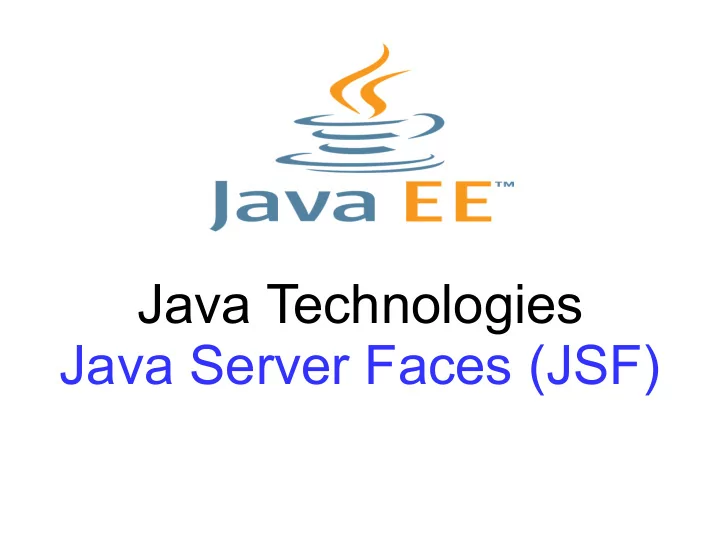

Java Technologies Java Server Faces (JSF)
The Context ● Web Components (Servlets, JSP, Beans, etc.) = “The Bricks” needed for creating Web Apps ● Frameworks are sets of design patterns, APIs, and runtime implementations intended to simplify the design and coding process for building new applications. → Enable application developers to concentrate on the unique feature set required by their applications.
Web Application Frameworks provide support for: ● Navigating among the application's pages ● Creating the presentation (forms, views, etc.) ● Accessing data (beans, etc.) and server resources (JDBC connections, etc.) ● Data validation and conversion (web ↔ model) ● Internationalization ● Secure access to resources ● Role separation , ...
Front Controller <!-- Request Mapping --> <servlet-mapping> <url-pattern>*.do</url-pattern> <servlet-name> com.some.mvc.framework.FrontController </servlet-name> </servlet-mapping> Provides a centralized entry point for handling requests
Java Server Faces Server-side component framework for building web applications: ● Offers an API for representing UI components and managing their server-side state ● Tag libraries for using components in pages and for connecting them to server-side objects ● Event based interaction model ● Support for server-side validation, data conversion; page navigation; internationalization ● Simplifies the process of building and maintaining web applications with server-side user interfaces
Server-Side UI
JSF Implementations Specifications: 1.0 (2004) → 1.2 (2006) → 2.0 (2009) → 2.1 (2010) → 2.2 (2013) → 2.3 (2015) → 2.4 (2017) Implementations ● Reference (included in GlassFish) ● Open-Source, Ajax-enabled: PrimeFaces Rich ICEFaces Internet JBoss RichFaces Applications Apache MyFaces, ...
Creating a Simple JSF Application ● Create the backing bean(s) ➔ PersonBean ● Write the pages ➔ inputName.xhtml, sayHello.xhtml ● Create the resource bundle ➔ Messages.properties ● Define navigation rules ➔ faces-config.xml
PersonBean package hello; import javax.faces.bean.ManagedBean; import javax.faces.bean.RequestScoped; the name of the bean @ManagedBean(name = "personBean") @RequestScoped the visibility domain public class PersonBean { private String name; //CDI @Named("personBean") public String getName() { → javax.inject.Named return name; @RequestScoped } → javax.enterprise.context public void setName(String name) { this.name = name; } }
inputName.xhtml <html xmlns="http://www.w3.org/1999/xhtml" xmlns:h="http://java.sun.com/jsf/html" > <h:head> <title> Hello </title> </h:head> <h:body> <h:form> <h:outputLabel for=" userName " value="Your name:"/> <h:inputText id=" userName " value="#{personBean.name}" required="true"/> <h:commandButton id="submit" value="Submit" action=" sayHello.xhtml " /> <h:message id="errors" style="color: red" showSummary="true" showDetail="false" for=" userName "/> </h:form> </h:body> </html>
Messages.properties The Resource Bundle contains messages displayed by the application # key = value title = Simple JSF Application greeting = Hello
sayHello.xhtml <html xmlns="http://www.w3.org/1999/xhtml" xmlns:h="http://java.sun.com/jsf/html" xmlns:f="http://java.sun.com/jsf/core" > <f:loadBundle basename="hello.Messages" var="message"/> <h:head> <title> #{message.title} </title> </h:head> <h:body> <h:form> <h2> #{message.greeting} #{personBean.name} ! </h2> <h:commandButton id="back" value="Back" action="inputName.xhtml" /> </h:form> </h:body> </html>
Page Navigation Replace actual file names with abstract actions: <h:commandButton id="submit" value="Submit" action="sayHello.xhtml"/> "sayHello.xhtml" → "hello" Define the navigation rules in faces-config.xml <faces-config> <navigation-rule> <from-view-id>/inputName.xhtml</from-view-id> <navigation-case> <from-outcome>hello</from-outcome> <to-view-id>/sayHello.xhtml</to-view-id> </navigation-case> </navigation-rule> </faces-config>
Configure JSF Environment in web.xml <web-app> <context-param> <param-name>javax.faces.application.CONFIG_FILES</param-name> <param-value> /WEB-INF/faces-config.xml </param-value> </context-param> <!-- Faces Servlet --> <servlet> <servlet-name> Faces Servlet </servlet-name> <servlet-class>javax.faces.webapp.FacesServlet</servlet-class> <load-on-startup> 1 </load-on-startup> </servlet> <!-- Faces Servlet Mapping --> <servlet-mapping> <servlet-name>Faces Servlet</servlet-name> <url-pattern> /faces/* </url-pattern> </servlet-mapping> </web-app>
Configure JSF Environment in faces-config.xml <faces-config version="2.2" … > Default JSF messages <application> <message-bundle> Messages </message-bundle> Global Resource Bundles <resource-bundle> <base-name>Messages</base-name> <var>msg</var> </resource-bundle> Supported Locales <locale-config> <default-locale>en</default-locale> <supported-locale>ro</supported-locale> </locale-config> </application> < navigation-rule id="main"> … Navigation Rules ... </faces-config>
JSF Architecture User Interface Component Model Component Rendering Model Backing / Managed Beans Model Conversion Model Event and Listener Model Validation Model Navigation Model
User Interface Component Classes ● Specify the component functionality , such as holding component state, maintaining a reference to objects, driving event handling and rendering for a set of standard components. ● Base class: UIComponentBase subclass of UIComponent , which defines the default state and behavior ● No definition of visual representation ● Examples: – UICommand UIForm UIPanel – UIOutput UIInput UIMessage – UIData UIColumn UIGraphic ...
Behavioral Interfaces ● The component classes also implement one or more behavioral interfaces, each of which defines certain behavior for a set of components whose classes implement the interface. – ActionSource, ActionSource2 ActionSource is an interface that may be implemented by any concrete UIComponent that wishes to be a source of ActionEvents, including the ability to invoke application actions via the default ActionListener mechanism. – ValueHolder, EditableValueHolder – NamingContainer, StateHolder, … Examples: UICommand implements ActionSource2, StateHolder UIOutput implements StateHolder, ValueHolder UIInput implements EditableValueHolder, StateHolder, ValueHolder
Component Rendering Model ● Renderer class → the view of a component – define the behavior of a component once – create multiple renderers ( Strategy Design Pattern) A Render kit defines how component classes map to component tags that are appropriate for a particular client. The JavaServer Faces implementation includes a standard HTML render kit for rendering to an HTML client. ● A component tag identifies the renderer Component Representation Tag UICommand HtmlCommandButton commandButton HtmlCommandLink commandLink UISelectOne HtmlSelectOneMenu selectOneMenu HtmlSelectOneRadio selectOneRadio HtmlSelectOneListbox selectOneListbox
Component Rendering Model ● Renderer class → the view of a component – define the behavior of a component once – create multiple renderers ( Strategy Design Pattern) A Render kit defines how component classes map to component tags that are appropriate for a particular client. The JavaServer Faces implementation includes a standard HTML render kit for rendering to an HTML client. ● A component tag identifies the renderer Component Representation Tag UICommand HtmlCommandButton commandButton HtmlCommandLink commandLink UISelectOne HtmlSelectOneMenu selectOneMenu HtmlSelectOneRadio selectOneRadio HtmlSelectOneListbox selectOneListbox
Backing / Managed Beans Model
Value Binding Value Binding PersonBean → String name ; <h:inputText id="userName" value="#{personBean.name}"/> @ManagedBean(name = "personBean") @SessionScoped public class PersonBean implements Serializable { private String name; public String getName() { return name; } public void setName(String name) { this.name = name; } }
Reference Binding Reference Binding PersonBean → UIInput nameComponent; <h:inputText id="userName" binding="#{personBean.nameComponent}"/> public class PersonBean { ... private UIInput nameComponent; public UIInput getNameComponent() { return nameComponent; } public void setNameComponent(UIInput nameComponent) { this.nameComponent = nameComponent; } public void someMethod() { nameComponent.setRendered(false); } }
Recommend
More recommend